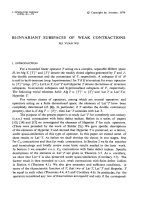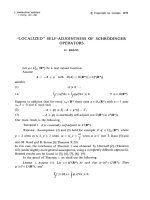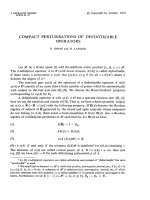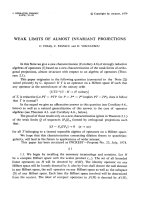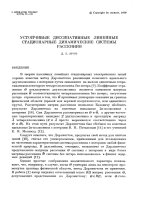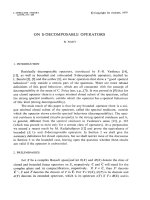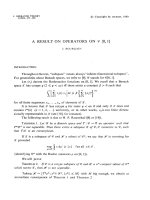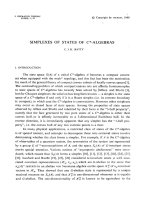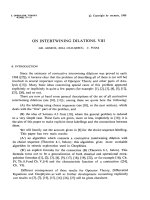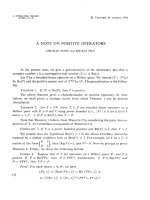Báo cáo toán học: "MULTICOLOURED HAMILTON CYCLES" docx
Bạn đang xem bản rút gọn của tài liệu. Xem và tải ngay bản đầy đủ của tài liệu tại đây (124.93 KB, 13 trang )
MULTICOLOURED HAMILTON
CYCLES
Michael Albert, Alan Frieze and Bruce Reed
∗
Department of Mathematics, Carnegie-Mellon University,
Pittsburgh, U.S.A.
†
Submitted: April 25th,1995
Accepted May 9th, 1995
Abstract
The edges of the complete graph
K
n
are coloured so that no colour
appears more than
cn
times, where
c<
1
/
32 is a constant. We show
that if
n
is sufficiently large then there is a Hamiltonian cycle in which
each edge is a different colour, thereby proving a 1986 conjecture of
Hahn and Thomassen [7]. We prove a similar result for the com-
plete digraph with
c<
1
/
64. We also show, by essentially the same
technique, that if
t
≥
3,
c<
(2
t
2
(1 +
t
))
−1
, no colour appears more
than
cn
times and
t
|
n
then the vertices can be partitioned into
n/t
t
−
sets
K
1
,K
2
, ,K
n/t
such that the colours of the
n
(
t
−
1)
/
2edges
contained in the
K
i
’s are distinct. The proof technique follows the
lines of Erd˝os and Spencer’s [2] modification of the Local Lemma [1].
∗
Current address of Bruce Reed: Equipe Combinatoire, CNRS, Universit´ePierreet
MarieCurie,4PlaceJussieu,Paris,France
†
Alan Frieze: partially supported by NSF grant CCR-9225008
1
the electronic journal of combinatorics 2 (1995), #R10 2
1 Introduction
Let the edges of the complete graph K
n
be coloured so that no colour is used
more than k = k(n) times. We refer to this as a k-bounded colouring. We say
that a subset of the edges of K
n
is multicoloured if each edge is of a different
colour. We say that the colouring is H-good if a multi-coloured Hamilton
cycle exists i.e., one with a multi-coloured edge-set. Clearly the colouring is
H-good if k =1andmaynotbeifk ≥ n/2, since then we may only use n− 1
colours. The main question we address here then is that of how fast can we
allow k to grow and still guarantee that a k-bounded colouring is H-good.
The problem is mentioned in Erd¨os, Nestril and R¨odl [3]. There they mention
it as an Erd¨os - Stein problem and show that k can be any constant. Hahn
and Thomassen [7] were the next people to consider this problem and they
showed that k could grow as fast as n
1/3
and conjectured that the growth
rate of k could in fact be linear. In unpublished work R¨odl and Winkler
[9]in1984improvedthiston
1/2
. Frieze and Reed [5] showed that there is
an absolute constant A such that if n is sufficiently large and k is at most
n/(A ln n) then any k-bounded colouring is H-good.
Inthispaperweremovethelogn factor and prove the conjecture of [7].
Theorem 1 If n is sufficiently large and k is at most cn,wherec<1/32
then any k-bounded colouring of K
n
is H-good.
We can extend this to the directed case.
Theorem 2 If n is sufficiently large and k is at most cn,wherec<1/64
then any k-bounded colouring of the edges of the complete digraph DK
n
is
the electronic journal of combinatorics 2 (1995), #R10 3
H-good.
As another wrinkle on this problem, we have
Theorem 3 Suppose the edges of K
n
are coloured so that the graphs induced
by the edges of a single colour all have maximum degree at most cn,where
c<1/32. Then there exists a Hamilton cycle in which each vertex is incident
with two edges of a distinct colours.
We prove Theorem’s 1, 2 and 3 as corollaries of the following.
Theorem 4 Let Γ be a graph whose vertex set is the edge set of K
n
.Suppose
that Γ has maximum degree bounded above by cn,wherec<1/32. Then K
n
contains a Hamilton cycle H whose edge set is an independent subset in Γ.
We finally consider multi-coloured sets of cliques of size t. More precisely,
assume that t ≥ 3,t|n,andletK = K
1
,K
2
, ,K
n/t
be a partition of [n]into
subsets of size n/t.WesaythatK is multi-coloured if the set of n(t − 1)/2
edges which have both endpoints in the same t-set is multi-coloured.
Theorem 5 If n is sufficiently large and k is at most cn, c<(2t
2
(1+t))
−1
,
then in any k-bounded colouring of the edges of K
n
there is multi-coloured
partition K.
2 Modification of the Lov`asz local lemma
Let A
1
,A
2
, ,A
N
denote events in some probability space. Using
¯
A to
denote the complement of an event A, we are as usual interested in showing
that Pr(
n
i=1
¯
A
i
) > 0.
the electronic journal of combinatorics 2 (1995), #R10 4
Suppose that for each i there is a partition of [N] \{i} into X
i
and Y
i
.Inthe
usual version of the local lemma, A
i
will be independent of the the events
in X
i
. Here all of the events will be interdependent, but one can still apply
the methodology of the usual proof of the local lemma. We should point out
here that this idea is not our own, it is already in Erd˝os and Spencer [2].
We consider one of the terms in the expression
Pr
N
i=1
¯
A
i
=
N
i=1
Pr
¯
A
i
|
i−1
j=1
¯
A
j
. (1)
We want to show that for 1 ≤ i ≤ N,
Pr
¯
A
i
|
i−1
j=1
¯
A
j
> 0. (2)
So, we try to prove by induction on |S|,S⊆ [N], that for i ∈ S,
Pr
A
i
|
j∈S
¯
A
j
≤ α, (3)
for some suitable choice of α.
Now,
Pr
A
i
|
j∈S
¯
A
j
=
Pr
A
i
∩
k∈S∩Y
i
¯
A
k
|
j∈S∩X
i
¯
A
j
Pr
k∈S∩Y
i
¯
A
k
|
j∈S∩X
i
¯
A
j
≤
Pr
A
i
|
j∈S∩X
i
¯
A
j
Pr
k∈S∩Y
i
¯
A
k
|
j∈S∩X
i
¯
A
j
≤
Pr
A
i
|
j∈S∩X
i
¯
A
j
1 −
k∈S∩Y
i
Pr
A
k
|
j∈S∩X
i
¯
A
j
(4)
the electronic journal of combinatorics 2 (1995), #R10 5
Let now
β =max{Pr(A
i
|
j∈T
¯
A
j
):i ∈ [N],T ⊆ X
i
}, (5)
and
m =max{|Y
i
| : i ∈ [N]}. (6)
We will have to prove that given m, β we can choose 0 ≤ α<1 such that
α(1 − mα) ≥ β. (7)
Assume that (7) holds. If S ⊆ X
i
then (5) and (7) will imply
Pr
A
i
|
j∈S
¯
A
j
≤ β
≤ α.
On the other hand if S ⊆ X
i
then we can apply the induction hypothesis to
Pr(A
k
|
j∈S∩X
i
¯
A
j
) in the numerator of (4) and obtain
Pr
A
i
|
j∈S
¯
A
j
≤
β
1 − mα
≤ α,
by (7).
The base case of the induction, S = ∅, follows from considering T = ∅ in (5)
and using β ≤ α.
So the proof of (2) rests on proving that (7) holds. This is what we do for
Theorem 4. The proof of Theorem 5 is slightly different, in that we need to
partition A
1
,A
2
, ,A
N
into two types of event.
It may be useful to summarise the above discussion as a lemma in case it
canbeusedinothercircumstances.
the electronic journal of combinatorics 2 (1995), #R10 6
Lemma 1 Let A
1
,A
2
, ,A
N
denote events in some probability space. Sup-
pose that for each i there is a partition of [N] \{i} into X
i
and Y
i
.Let
m =max{|Y
i
| : i ∈ [N]} and β =max{Pr(A
i
|
j∈T
¯
A
j
):i ∈ [N],T ⊆ X
i
}.
If there exists 0 ≤ α<1 such that α(1 − mα) ≥ β then Pr(
n
i=1
¯
A
i
) > 0.
3 Hamilton Cycles
3.1 Proof of Theorems 1 and 2
We show here that Theorems 1 and 2 are corollaries of Theorem 4. Assume
n is large and k ≤ cn, and an arbitrary k-bounded colouring of K
n
is given.
To prove Theorem 1 we define Γ as follows. Two edges e, f of K
n
correspond
to the endpoints of an edge of Γ if and only if they have the same colour.
Thus a set of vertices of Γ is independent if and only it corresponds to a
multicoloured set of edges of K
n
. Clearly the maximum degree of Γ is at
most k − 1 and so we can apply Theorem 4 to obtain Theorem 1.
To prove Theorem 2 we need a slight change in the definition of Γ. Two edges
e = {e
0
,e
1
},f = {f
0
,f
1
} of K
n
define an edge of Γ if and only if the colours
of the four directed edges (e
0
,e
1
), (e
1
,e
0
), (f
0
,f
1
), (f
1
,f
0
) are not all distinct.
Thus a set S of vertices of Γ is independent if and only the set of edges
obtained by taking, each e = {e
0
,e
1
}∈S and replacing it by (e
0
,e
1
), (e
1
,e
0
)
(giving 2|S| directed edges) is multicoloured. Clearly the maximum degree
of Γ is at most 2(k − 1) and so we can apply Theorem 4 to obtain a slight
strengthening of Theorem 1 viz. there is a Hamilton cycle and its reversal
spanning a multicoloured set of directed edges.
the electronic journal of combinatorics 2 (1995), #R10 7
ToproveTheorem3welettwoedgese, f of K
n
correspond to the endpoints
of an edge of Γ if and only if they have the same colour and are incident with
a common vertex.
3.2 Proof of Theorem 4
Let H be a Hamilton cycle chosen uniformly at random from the set of (n −
1)!/2 Hamilton cycles of K
n
.Let{(e
i
,f
i
): 1≤ i ≤ N} be an enumeration
of the edges of Γ. Let
A
i
= {H : e
i
,f
i
are both edges of H}.
We will prove Theorem 1 by using the argument of Section 2 to show that
Pr
N
i=1
¯
A
i
> 0. We use the notation of that section.
For 1 ≤ i ≤ N let
Y
i
= {j = i :(e
j
∪ f
j
) ∩ (e
i
∪ f
i
) = ∅}.
Thus j ∈ Y
i
if in K
n
,oneofe
j
,f
j
shares a vertex with one of e
i
,f
i
.Let
X
i
=[N] \ (Y
i
∪{i}). Clearly, |Y
i
|≤4cn
2
and so
m ≤ 4cn
2
.
We will show that
β ≤
2
n
2
− 15n +56
(8)
and Theorem 1 follows on choosing
α =
1
8c
1 −
1 − (32 + )c
n
−2
and checking that (7) holds for >0 sufficiently small and n sufficiently
large.
the electronic journal of combinatorics 2 (1995), #R10 8
[Now mα ≤ (1 −
1 − (32 + ))/2andso1− mα ≥ (1 +
1 − (32 + ))/2.
Thus α(1 − mα) > (2 + /16)n
−2
.]
Equation (8) follows from the following Lemma:
Lemma 2 Let e, f be edges of K
n
and X ⊆ E(K
n
) be such that no edge
in X shares an endpoint with either e or f. Then we can find, for each
Hamilton cycle C containing both e and f and no edges of X,asetS(C) of
(n − 6)(n − 9)/2 Hamilton cycles containing neither e, f or any edge in X,
in such a way that if C = C
then S(C) ∩ S(C
)=∅.
Proof Let e
0
,e
1
and f
0
,f
1
be the endpoints of e and f respectively,
chosen so that e
0
has the smallest index of e
0
,e
1
,f
0
,f
1
.Let
C = e
0
,e
1
−→ f
0
,f
1
−→ e
o
.
[It is possible that e
1
= f
0
here.]
Consider two disjoint edges x =(x
0
,x
1
),y =(y
0
,y
1
)ofC sharingnoendpoint
with e or f.Thereareatleast(n − 6)(n − 9)/2choicesforx, y.Thereare
now two possibilities:
C = e
0
,e
1
−→ x
0
,x
1
−→ f
0
,f
1
−→ y
0
,y
1
−→ e
o
.
or
C = e
0
,e
1
−→ f
0
,f
1
−→ x
0
,x
1
−→ y
0
,y
1
−→ e
o
.
In the first case define:
ˆ
C
x,y
= e
0
,x
0
−→ e
1
,y
0
−→ f
1
,x
1
−→ f
0
,y
1
−→ e
o
.
In the second case define:
the electronic journal of combinatorics 2 (1995), #R10 9
ˆ
C
x,y
= e
0
,x
1
−→ y
0
,f
1
−→ x
0
,e
1
−→ f
0
,y
1
−→ e
o
.
In both cases we delete the edges e, f, x, y from C and add edges that are
incident with one of e
0
,e
1
,f
0
,f
1
,sothat
ˆ
C
x,y
does not contain an edge of X.
It is important to realise that in both cases the procedure is reversible in
that C can be reconstructed from
ˆ
C
x,y
.Wecanrecognisewhichcaseweare
in from the relative order of the e’s and f’s and then identify the x’s and y’s
from their positions.
Thus taking S(C)={
ˆ
C
x,y
: x, y as above },weobtain|S(C)|≥(n − 6)(n −
9)/2andS(C) ∩ S(C
)=∅ for C = C
. ✷
To prove (8) we apply Lemma 2 with i ∈ [N], {e, f} = {e
i
,f
i
} and X ⊆ X
i
.
Let C denote the set of Hamilton cycles containing e
i
and f
i
.Then
Pr(A
i
|
j∈X
¯
A
j
)=
C∈C
Pr(H = C |
j∈X
¯
A
j
)
≤
2
n
2
− 15n +56
C∈C
Pr(H ∈{C}∪S(C) |
j∈X
¯
A
j
)
≤
2
n
2
− 15n +56
.
This completes the proof of Theorem 4.
4 Partition into cliques
Assume n is large and k ≤ cn, c<(2t
2
(1 + t))
−1
, and an arbitrary k-
bounded colouring of K
n
is given. Let {(S
1
,T
1
), (S
2
,T
2
), ,(S
N
,T
N
)} be
an enumeration of the pairs of t-subsets of [n] such that for each 1 ≤ i ≤ N
either (a) S
i
= T
i
and S
i
contains a pair of edges e, f of the same colour, or
the electronic journal of combinatorics 2 (1995), #R10 10
(b) S
i
∩ T
i
= ∅ and there are edges e, f of the same colour, e ⊆ S
i
,f ⊆ T
i
.
In either case we say that (S
i
,T
i
)containse, f.
Let I
a
= {i ∈ [N]:S
i
= T
i
} and I
b
=[N]\I
a
.NowletK be chosen randomly
from the set of possible partitions and define the events
A
i
= {S
i
and T
i
are both members of K}.
Once again, we prove that Pr(
n
i=1
¯
A
i
) > 0.
We now define Y
i
= {j = i : the following three conditions hold:
1. max{|S
j
∩ S
i
|, |S
j
∩ T
i
|≥t − 1.
2. max{|T
j
∩ S
i
|, |T
j
∩ T
i
|≥t − 1.
3. (S
j
,T
j
) contains a pair of identically coloured edges e, f which are not
containedin(S
i
,T
i
)}.
Naturally, X
i
=[N] \ (Y
i
∪{i}).
We elaborate the argument of Section 2. We prove the existence of 0 <
α
a
,α
b
< 1 such that if S ⊆ [N]andi ∈ I
x
\ S,wherex = a or b,then
Pr
A
i
|
j∈S
¯
A
j
≤ α
x
.
To do this, we define, for x = a or b,
β
x
=max{Pr(A
i
|
j∈T
¯
A
j
):i ∈ I
x
,T ⊆ X
i
}
and
m
x
=max{|Y
i
| : i ∈ I
x
}.
the electronic journal of combinatorics 2 (1995), #R10 11
We will then, in analogy with (7), only need to show that for x = a or b,
α
x
(1 − m
a
α
a
− m
b
α
b
) ≥ β
x
. (9)
Considerfirstthecasewherei ∈ I
a
.Thenj ∈ X
i
implies j ∈ I
a
.
[|S
j
∩ T
j
|≥|S
j
∩ S
i
∩ T
j
∩ S
i
|≥|S
j
∩ S
i
| + |T
j
∩ S
i
|−|S
i
|≥2(t − 1) − t>0.]
Now
m
a
≤ t
t − 1
2
k. (10)
Explanation: We choose S
j
by (i) choosing x ∈ S
i
,(ii)e = {x
1
,x
2
}⊆
S
i
\{x} and then y ∈ S
i
such that the colour of e isthesameasthatof
{x
1
,y} or {x
2
,y}.WethentakeS
j
=(S
i
\{x}) ∪{y}.
We argue next that
β
a
≤
1
t(n − t +1)
. (11)
Explanation: Given K∈A
i
∩
j∈T
¯
A
j
, T ⊆ X
i
,wecanobtaint(n − t)
distinct partitions which are in
¯
A
i
∩
j∈T
¯
A
j
as follows: Choose x ∈ S
i
and
y ∈ S,whereS is another t-set of K.ReplaceS
i
by (S
i
∪{y}) \{x} and S
by (S ∪{x}) \{y} to obtain K
.NotethatgivenK
we can re-construct K:
x is the unique element of S
i
whichisinasetwithelementsnotinS
i
and
y ∈ S
i
istheuniquesuchelementwhichinasetwitht − 1membersofS
i
.
Now let us consider the case i ∈ I
b
.Nowj ∈ X
i
implies that j ∈ I
b
.Also,
m
b
≤ t
2
t − 1
2
(t − 1)(n − t)k. (12)
Explanation: We choose S
j
,T
j
by (i) choosing x ∈ S
i
,y ∈ T
i
,(ii)e =
{x
1
,x
2
}⊆S
i
\{x}, (iii) z ∈ S
i
,(iv)w ∈ T
i
\{y},(v)v ∈ [n] such that the
colour of {v, w} is the same as that of e.ThentakeS
j
=(S
i
\{x}) ∪{z}
the electronic journal of combinatorics 2 (1995), #R10 12
and T
j
=(T
i
\{y}) ∪{w}. There are some restrictions on the choices of
x, y, z, v, w which are ignored for the purposes of getting an upper bound.
Finally,
β
b
≤
1
t
2
(n − 2t)(n − 3t)+1
. (13)
Explanation: Given K∈A
i
∩
j∈T
¯
A
j
, T ⊆ X
i
, we can obtain t
2
(n−2t)(n−
3t) distinct partitions which are in
¯
A
i
∩
j∈T
¯
A
j
as follows: Choose x ∈ S
i
and y ∈ T
i
. Then choose x
,y
∈ S
i
∪T
i
in distinct subsets S, S
of K.Replace
S
i
by (S
i
∪{x
}) \{x}, T
i
by (T
i
∪{y
}) \{y}, S by (S ∪{x}) \{x
} and
T by (T ∪{y}) \{y
}.toobtainK
. Note once again, that given K
we can
re-construct K.
With these values for m
a
,m
b
,β
a
,β
b
we can enforce (9) by choosing
α
a
=2/t and α
b
=2/t
2
.
This completes the proof of Theorem 5.
References
[1] N.Alon and J.H.Spencer, The probabilistic method, John Wiley and
Sons, New York, 1992.
[2] P.Erd˝os and J.Spencer, Lopsided Lov´asz local lemma and Latin transver-
sals, Discrete Applied Mathematics 30 (1990) 151-154.
[3] P.Erd¨os, J.Nesetril and V.R¨odl, Some problems related to partitions of
edgesofagraphin Graphs and other Combinatorial topics, Teubner,
Leipzig (1983) 54-63.
the electronic journal of combinatorics 2 (1995), #R10 13
[4] T.I.Fenner and A.M.Frieze, On the existence of polychromatic sets of
edges in graphs and digraphs, Progress in Graph Theory, Edited by J.A.
Bondy and U.S.R. Murty, Academic Press, 219-232.
[5] A.M.Frieze and B.A.Reed, Polychromatic Hamilton cycles,Discrete
Mathematics 118, (1993) 69-74.
[6] W.H¨oeffding,Probability inequalities for sums of bounded random vari-
ables, Journal of the American Statistical Association 58 (1963) 13-30.
[7] G.Hahn and C.Thomassen, Path and cycle sub-Ramsey numbers and an
edge-colouring conjecture, Discrete Mathematics 62 (1986) 29-33.
[8] L.P´osa,Hamilton circuits in random graphs,Discrete Mathematics 14
(1976) 359-64.
[9] P.Winkler, Private Communication.
